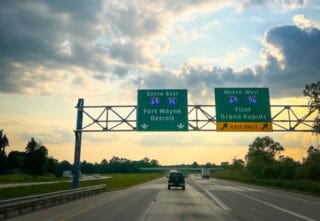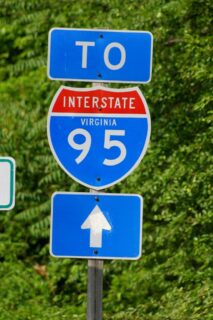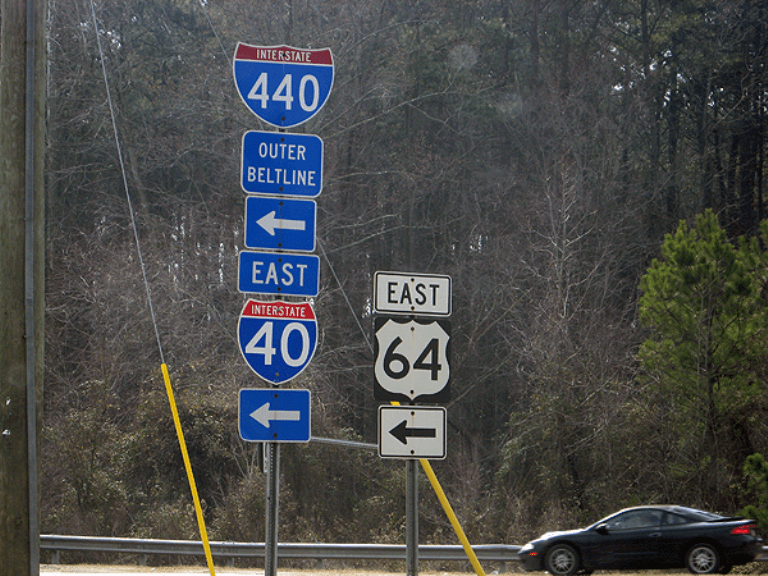Interstate guide signs play a crucial role in providing clear and concise navigation for travelers on the vast network of highways across the United States. These iconic signs are designed to convey essential information such as route numbers, exit numbers, and directions to major cities and attractions, ensuring that drivers can make informed decisions while on the road.
With their distinctive blue or green backgrounds and white lettering, interstate guide signs are instantly recognizable and serve as a vital tool for enhancing safety and efficiency on the interstate system. Whether it’s guiding commuters through urban areas or leading vacationers to their desired destinations, they stand as an integral part of the American road trip experience.
What Does “Interstate Guide Signs” Mean?
Interstate guide signs serve as a visual communication tool on the extensive interstate highway system, conveying crucial information to drivers about upcoming exits, major cities, and points of interest. These signs use standardized symbols and clear typography to indicate route numbers, directions, and distances, helping travelers navigate the complex network of highways with ease. By providing consistent and easily understandable guidance, they enable drivers to make informed decisions, stay on course, and reach their destinations efficiently. Whether it’s guiding motorists through unfamiliar territory or assisting truckers in planning their routes, these signs play a vital role in ensuring safe and reliable travel on the nation’s highways.
Shape, Location, Color
Shape

The shape of interstate guide signs is standardized to ensure universal recognition and understanding. Typically, these signs are rectangular with the longer side oriented horizontally, allowing for clear visibility and readability from a distance. This uniform shape helps drivers quickly identify and process the information presented on the signs, contributing to safer navigation on the highways.
Location

Interstate guide signs are strategically located along the highways to provide timely and relevant information to drivers. They are positioned in advance of exits, junctions, rest areas and major interchanges, allowing motorists ample time to make lane changes or prepare for upcoming turns. Placed at consistent intervals and at key decision points, these signs serve as crucial navigational aids, ensuring that drivers can anticipate and react to changes in the road ahead.
Color

The color scheme of interstate guide signs is distinctive, with a deep blue or green background and white lettering. This color combination is specifically chosen to maximize contrast and visibility, especially against the backdrop of the surrounding landscape and varying weather conditions. The bold blue or green hues make interstate guide signs easily recognizable, while the crisp white lettering enhances legibility, even at high speeds. This deliberate choice of color ensures that the signs stand out prominently, commanding attention and delivering essential information to drivers on the nation’s highways.
What Materials are Interstate Guide Signs Made of?
 They are made using steel uprights and retro-reflective sheeted aluminum to withstand the elements. This aluminum can be either flat-sheet or extruded, with extruded panels being composed of multiple sections bolted together for larger signs.
They are made using steel uprights and retro-reflective sheeted aluminum to withstand the elements. This aluminum can be either flat-sheet or extruded, with extruded panels being composed of multiple sections bolted together for larger signs.
The surface of these aluminum signs is then laminated with retro-reflective sheeting, which is a specialized material designed to reflect light back to its source, such as a car’s headlights, ensuring that the signs are visible at night. This sheeting is made from tiny glass beads or microprisms embedded in a flexible PVC surface.
The use of retro-reflective materials on interstate guide signs is a critical safety feature, as it significantly enhances nighttime visibility and helps prevent accidents. In addition to the sign panels themselves, the support structures for these signs are also made from robust materials. Commonly used materials for sign posts include wood, steel U-channel, perforated square tube, and sometimes aluminum.
Larger support structures, such as cantilever structures or sign bridges, are usually constructed from steel to provide the necessary strength to hold up the signs over busy highways. The combination of aluminum sign panels with retro-reflective sheeting, supported by sturdy posts and structures, ensures that interstate guide signs are both visible and durable, capable of guiding drivers safely for years to come.
Who Regulates Interstate Guide Signs?
The regulation of interstate guide signs is a collaborative effort between state governments and the Federal Highway Administration (FHWA). While the states own and operate the Interstate Highways, they are responsible for setting operating requirements, such as speed limits, and for the enforcement of these regulations. However, the FHWA holds the ultimate authority to approve or disapprove Interstate route numbers, which includes the oversight of guide signs to ensure consistency and compliance with federal standards.
This partnership ensures that while states can tailor their highway operations to meet local needs, there remains a cohesive and unified system of navigation aids across the entire Interstate Highway System, which was officially named the Dwight D. Eisenhower National System of Interstate and Defense Highways in honor of the president who greatly contributed to its creation.
Are Interstate Guide Signs Required to be MUTCD-Compliant?
Yes, they are required to be MUTCD (Manual on Uniform Traffic Control Devices) compliant. The MUTCD sets the standard for the design, application, and placement of traffic control devices, including signs, signals, and pavement markings, to ensure uniformity and safety on the nation’s roadways. As such, interstate guide signs must adhere to the guidelines outlined in the MUTCD to maintain consistency and clarity for drivers across state lines. By following these standards, these signs may effectively convey essential information to motorists, promoting safe and efficient navigation throughout the extensive highway system.
Do Interstate Guide Signs Need to be Retro-reflective?
Yes, they are required to be retro-reflective. The retro-reflective properties of these signs are essential for ensuring their visibility and legibility, especially during nighttime and low-light conditions. By using retro-reflective sheeting on the surface of the signs, they effectively reflect light from headlights back to the drivers, making the signs highly visible and improving overall safety on the highways. This retro-reflective feature is a crucial aspect of interstate guide sign design, as it enhances driver awareness and contributes to the overall effectiveness of the nation’s highway signage system.
What is the Meaning Behind the Numbers on the Interstate Signs?
 The numbers on interstate signs are not arbitrary; they follow a logical system that helps drivers understand the direction and location of the routes. Major east-west interstate highways are assigned even numbers, with those ending in “0” being major routes that typically span the width of the country, and the numbers increasing from north to south. Conversely, major north-south interstates have odd numbers, ending in “5” for key routes, with lower numbers starting in the west and increasing towards the east.
The numbers on interstate signs are not arbitrary; they follow a logical system that helps drivers understand the direction and location of the routes. Major east-west interstate highways are assigned even numbers, with those ending in “0” being major routes that typically span the width of the country, and the numbers increasing from north to south. Conversely, major north-south interstates have odd numbers, ending in “5” for key routes, with lower numbers starting in the west and increasing towards the east.
Three-digit interstate numbers signify minor routes, with the last two digits corresponding to the major interstate they branch from; an even first digit indicates the route will reconnect with the major interstate, while an odd first digit means it will not. This numbering system, established in the 1950s, was designed to be the opposite of the earlier U.S. Highway system to avoid confusion and facilitate navigation.
Conclusion
Interstate guide signs are a crucial component of the nation’s highway system, designed to provide clear and consistent navigation for drivers. Constructed from durable materials such as aluminum and retroreflective sheeting, these signs are built to withstand the rigors of the road and remain highly visible, even in low-light conditions. The regulations governing interstate guide signs, including the requirement for MUTCD compliance and retroreflectivity, ensure that these signs effectively convey essential information to motorists, promoting safe and efficient travel across state lines. CHECK HERE for MUTCD-compliant interstate traffic signs.
Popular Posts:




